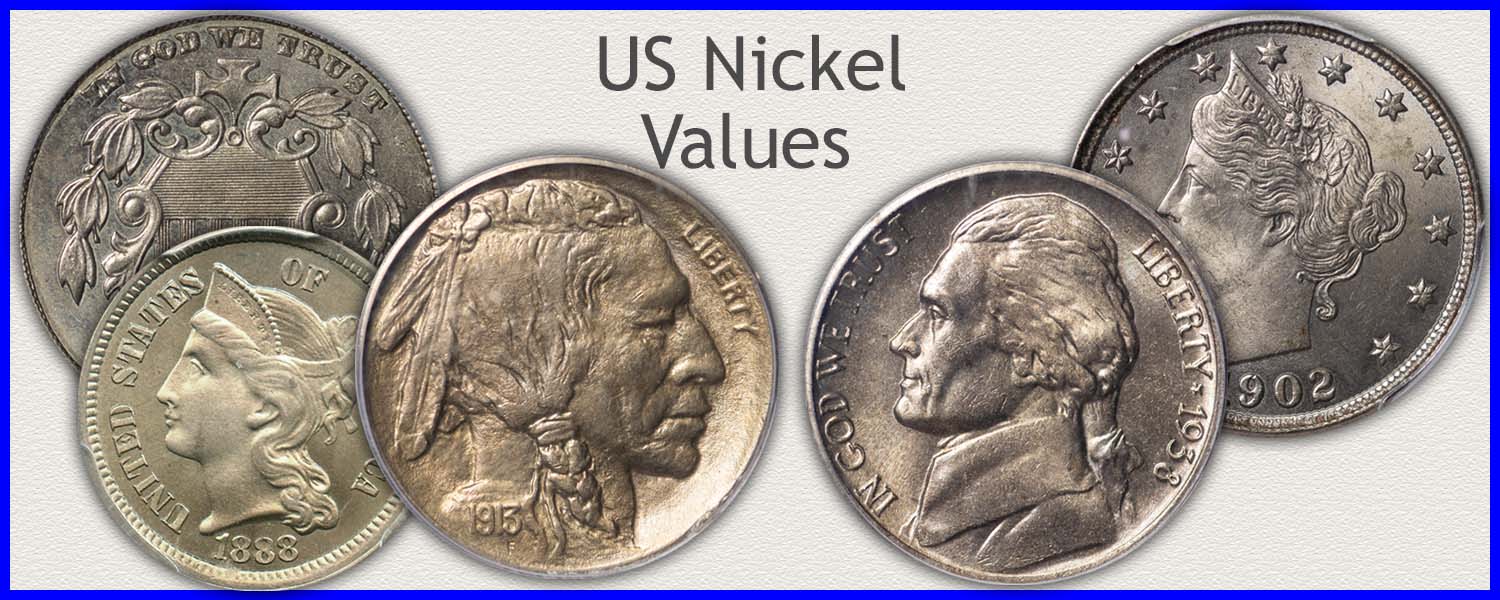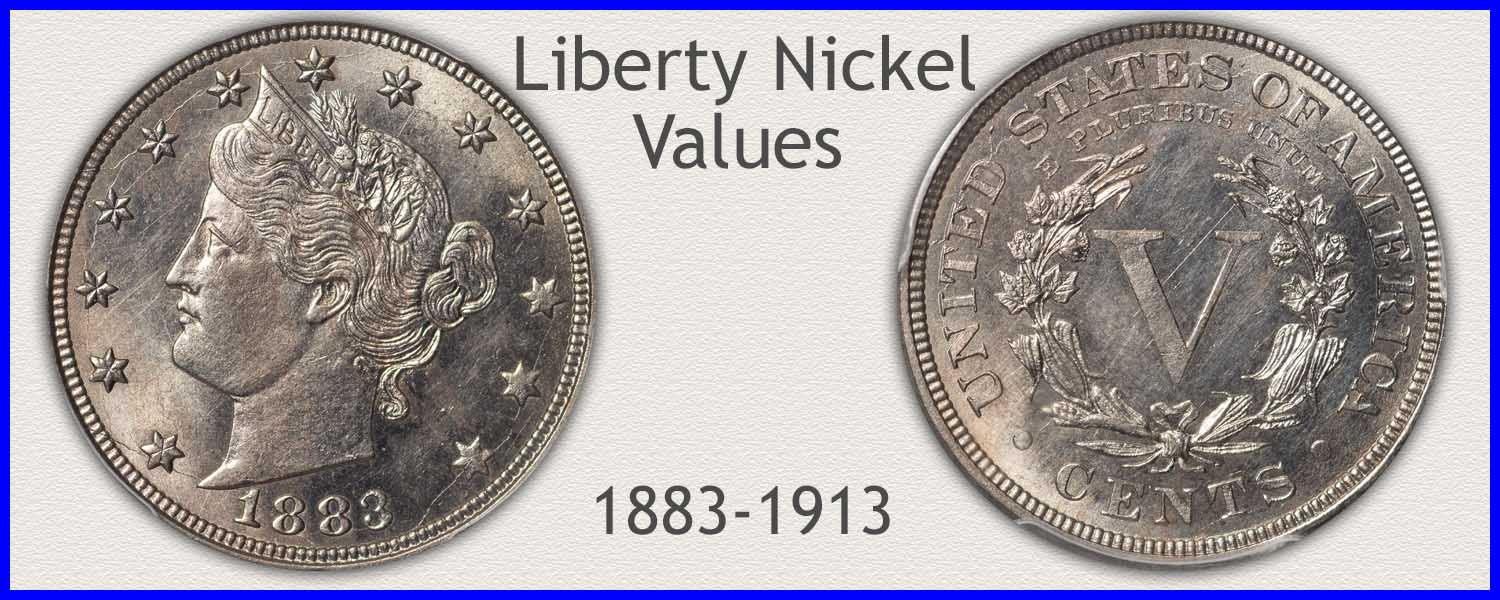Coin Values Moving with Precious Metals: Up-Dated 4/14/2025: Gold $3226 | Silver $31.88
1891 Nickel Value
A collector inspects a coin's condition closely when determining 1891 nickel value. This is an important date in the Liberty nickel series, which is somewhat scarce.
With the focus of the market on condition and how much these coins are worth, judging condition within a narrow range is a key consideration. Condition of your coin is compared to images of different "grades" of nickels. These grades represent descriptions used in the coin hobby.
Proceed through the steps to become familiar with this nickel series, the significance of the date, condition, and special quality of these coins.
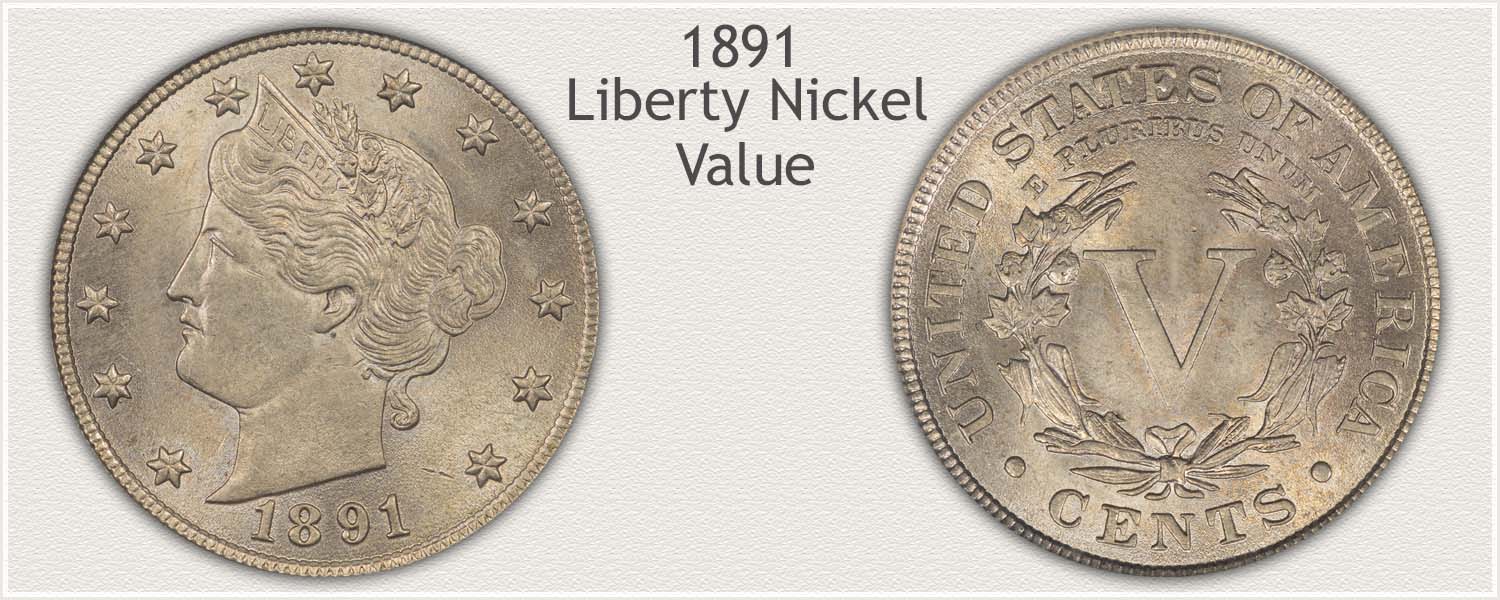
Steps Leading to Value:
- Step 1: Date Identified - An important date in the Liberty series of nickels to confirm.
- Step 2: Grading Condition - Strong increases in premiums require close inspection of quality.
- Step 3: Special Qualities - Added detail is imaged and reviewed to find subtle qualities in these coins.
| 1891 Nickel Value | ||||
|---|---|---|---|---|
| Condition of Coin | ||||
| Date | Good | Fine | Extremely Fine |
Mint State |
| Liberty Nickel Value Updated | 2024 | |||
| 1891 | $4.55 | $23 | $46 | $91 |
The value chart lists a range of wholesale values these scarce nickels trade within the market. A range is necessary because precise grading varies per coin.
Step 1: Recognize a Premium Liberty Nickel Date
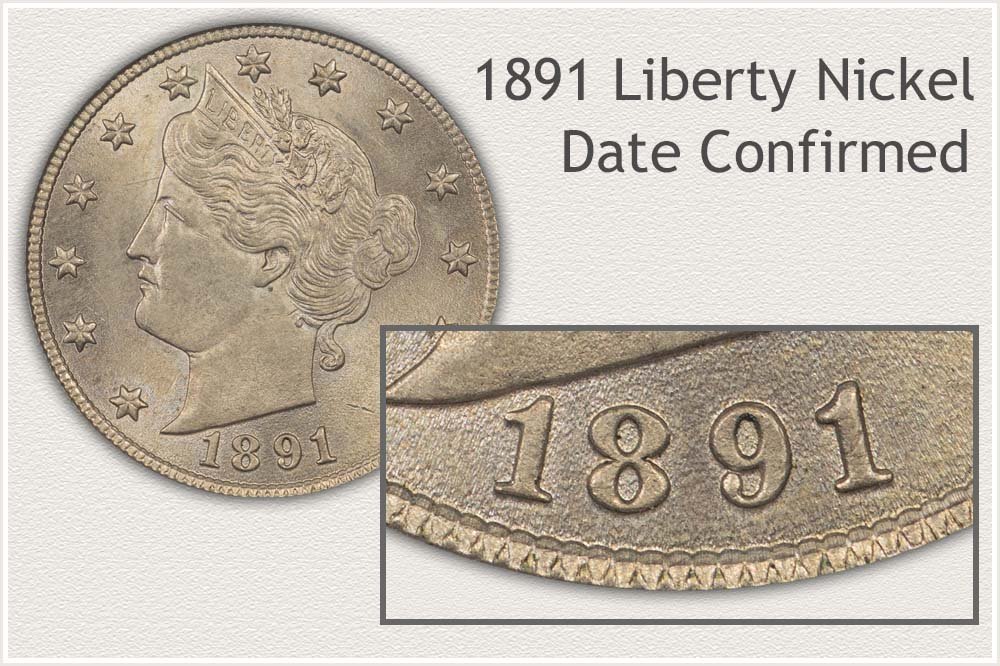
During the early 1890's production of Liberty nickels was still climbing, with increasing numbers minted each year. Philadelphia, the sole mint striking nickels at the time, placed into circulation just over 16.8 million pieces. 1891 nickels today are considered a slightly better date within the series in terms of scarcity. These are not as commonly available as later dated issues.
The coin market and hobby are data oriented. Close attention to recording the correct date is part of the value process and description of each coin.Step 2: | Grading is a Visual Inspection Judging the Amount of Wear
Visible Details on the Coin Identify Above Average Condition
1891 nickel value is divided into two significant groups. Heavily worn coins in Good condition are plentiful, the average Grade of the year. Infrequently found are examples of the date with the key feature of a full "Liberty" readable within her headband. These above average quality pieces are high premium coins when the condition is confirmed.
Grades are terms used within the coin hobby as classifications denoting different stages of wear. Each grade is recognized by specific details remaining. A readable "Liberty" is one, identify additional elements to further refine a narrow grade range. The process begins with a comparison among the following images, these represent standard grades. An initial close match for a potential grade is then verified. Continue by judging the presence of necessary details to reach the grade as described in the definition.
Mint State Grade
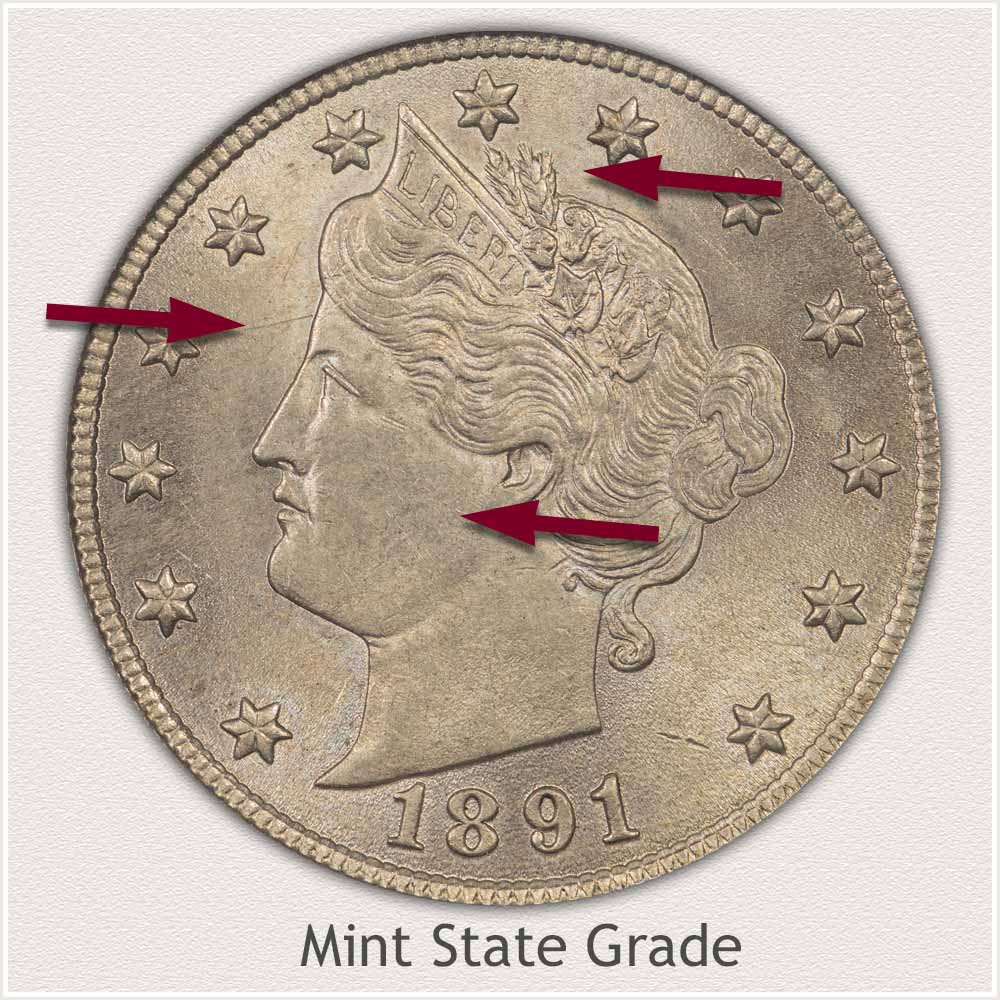
Mint State: Before assigning the Mint State grade, it is important to confirm the surface of the coin is not worn. These mint condition nickels retain their original luster, have fully intact high reliefs and recesses, and have no wear to the coin's fields.
First inspect, and determine original luster is still present. This luster shines across the surface of the coin as it is turned and tilted in front of a light. A Mint State nickel's fine texture, which causes luster to shine, is caused by striking the metal under high pressure during the minting process. In order to detect wear, tilt the coin under a light and look for dull and smooth areas, starting with Liberty's eye brows and cheeks.
The next design elements evaluated are the small high points of contours. Wear quickly dulls the original silvery-gray color of the metal and removes the roundness of contours. The wreath's leaves, wheat grains, and the very tip of the headband are all given a thorough inspection. Surfaces that are intact and show no signs of dulling or smoothness receive a grade of "Mint State".
Extremely Fine Grade
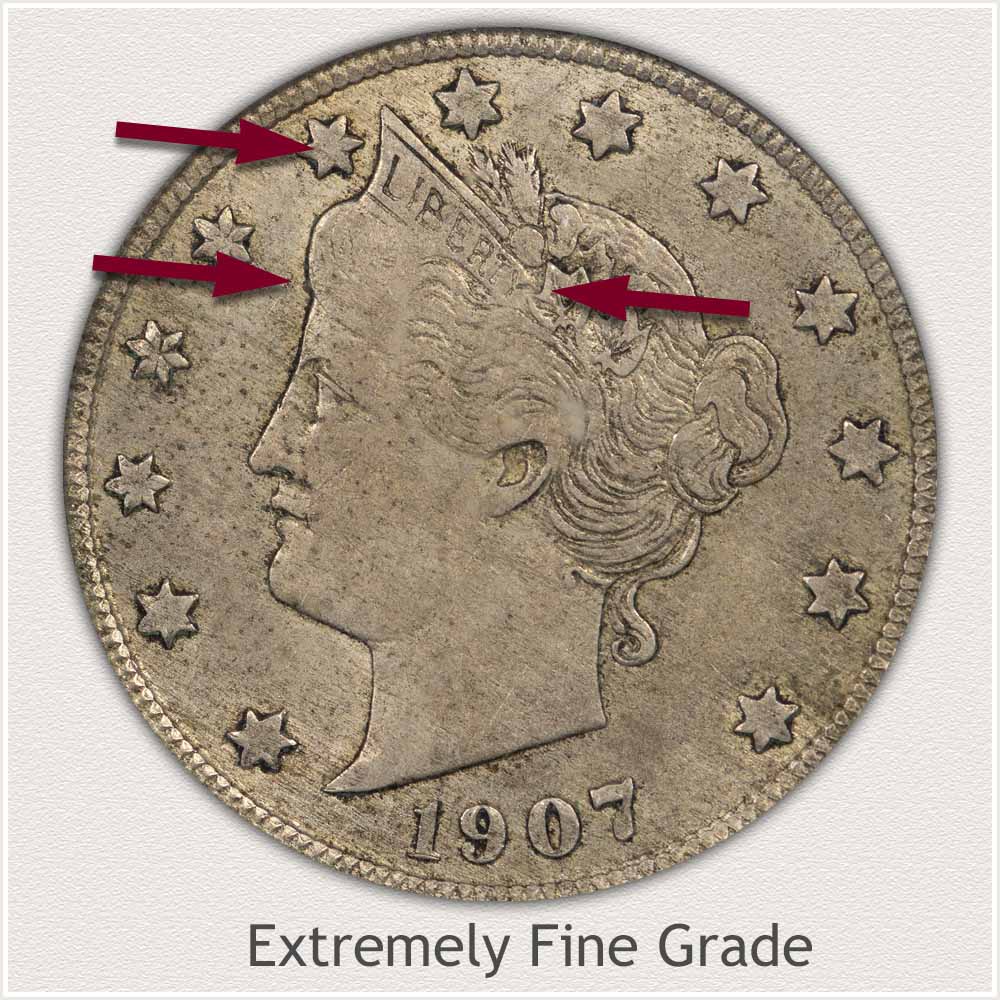
Extremely Fine: When the coin's brilliant shine disappears and replaced by a uniform gray tone, wear is now present on the surface. Defining the Extremely Fine grade is the minimal flattening caused by wear. On the design's high profile points, there is only a very slight smoothing visible.
Almost all fine lines in Liberty's hair remain visible and distinct in order to receive the grade. Only small visible signs of flattening and wear are the few missing and merged hair lines just above her forehead. It takes a crisp overall appearance to reach this level of condition.
The letters "LIBERTY" are readable in their entirety in the example image. These letters are still boldly impressed into the headband. This headband and lettering are prominent features of Liberty's design and crucial to Liberty nickel grading. The band has both upper and lower visible edges. Furthermore, bold letters are required to achieve the grade's high quality and appeal.
Fine Grade
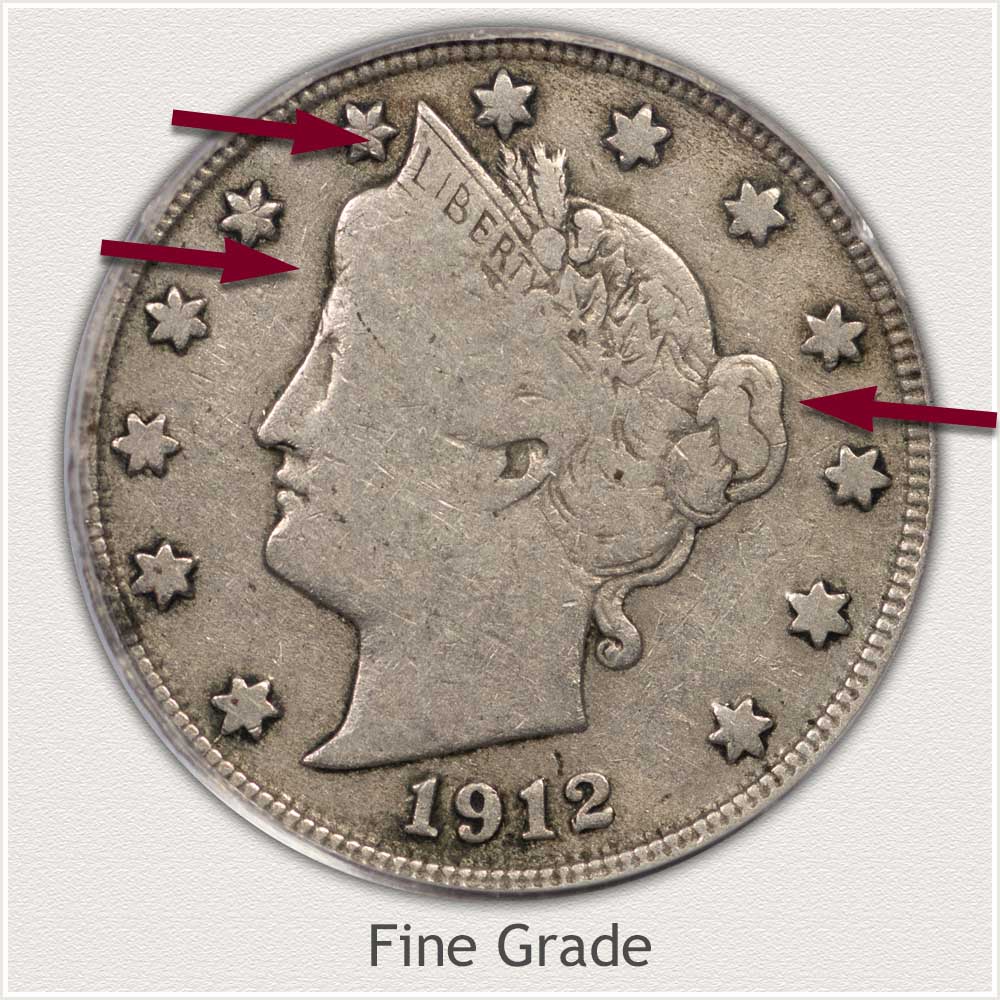
Fine Grade: Liberty nickels in the Fine grade have a unique quality recognized by the coin market. Visible small details remain among widespread obvious wear. The major features on these moderately worn nickels are beginning to fade. Minor and small details in protected areas are also starting to flatten and fade visibly.
The heavily worn areas of these nickels, as displayed in the example image, are affecting their overall appearance. A prominent feature, Liberty's hair, is now a flattened area without a separation line in the area along her forehead. From her forehead to her ear, the metal has worn down to a smooth, continuous, flat surface. Additionally, the hair tie at the back of her head is a flat area now presented as three segments with no inner details.
However, the grade does retain a few desirable qualities. Between her ear and the back of her head, the waves of hair still display well-defined lines. Second, and importantly, the entire "LIBERTY" within the headband is visible. Often the "I" located at a high point of the contour is less bold than the other letters. To qualify for the Fine grade level, all letters must remain legible.
Good Grade
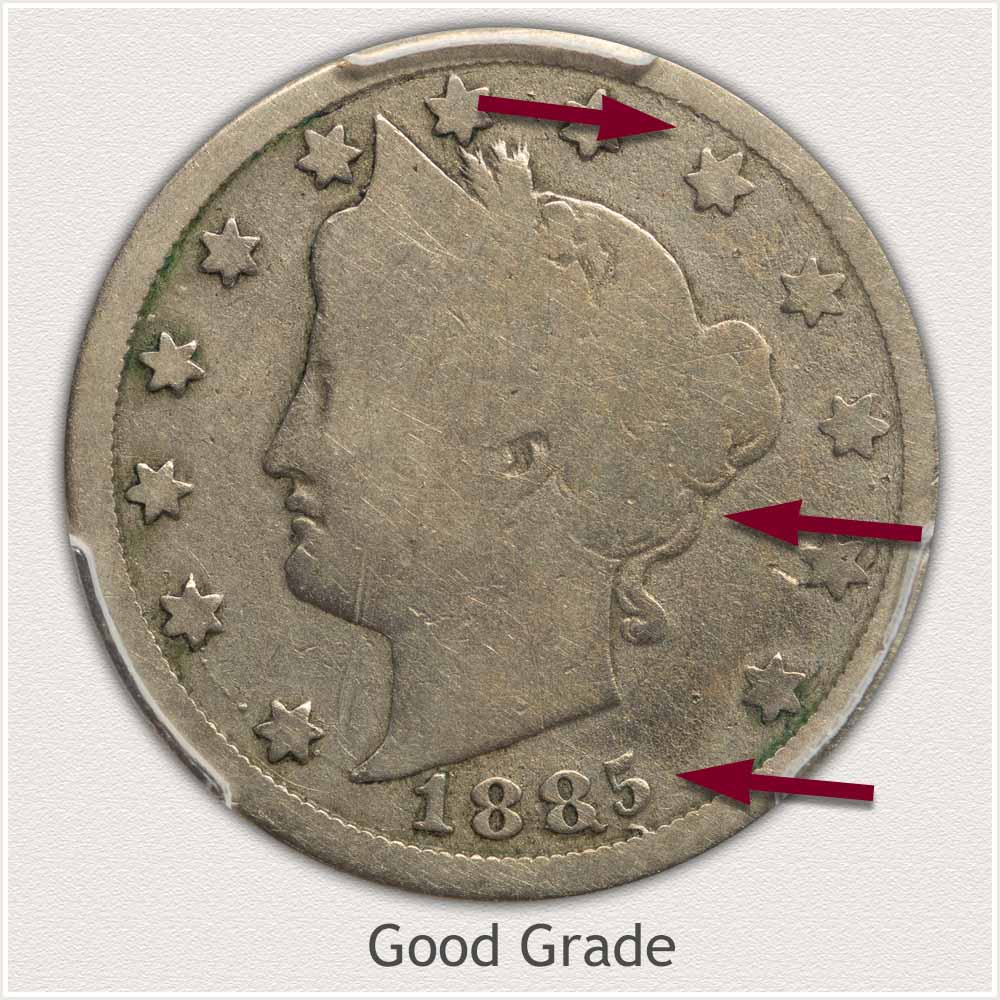
Good Grade: The condition of a coin is considered in the Good grade range once the majority of the portrait within Liberty's central area has lost its smaller details.
Wear has flattened Liberty's contoured features, hair, and headband. There is now only an outline. A few positives are required to qualify as a Good grade quality Liberty nickel. First, there is no fading of her outline into the coin's field, an important metric. Often, the back of her head is affected by a faded outline. Verify the raised edge defining the portrait is complete with no fading.
Furthermore, completely separate from the inner edge of the rim, all thirteen stars are discernible and distinct. Fading or missing stars indicate lower quality and less appeal to collectors. The key elements that remain visible are her portrait, stars, rim, and date, and they are all distinct from one another.
How to Video: Grading Liberty Nickels
Examine these Liberty nickels in more detail. Judge subtle features and added areas of the surface, helping confirm an initial assessment. Both the video and images expand the grading process.
Grading Liberty Nickels | How to Video and Descriptions
Step 3: | Special Qualities | Found in All Grades of Condition
Three Qualities Combined Showcase Special Quality Liberty Nickels
Quality examples of Liberty nickels, in all grades, have a market. Going beyond the technical grade, are certain features appealing to different collectors. Some hobbies tend to favor subtle, natural toning of the nickel. Others are keen on solid, well struck pieces. Many seek coins with a complete lack of marks on the surface. An old nickel meeting all these qualities is universally appealing, and notably scarce.
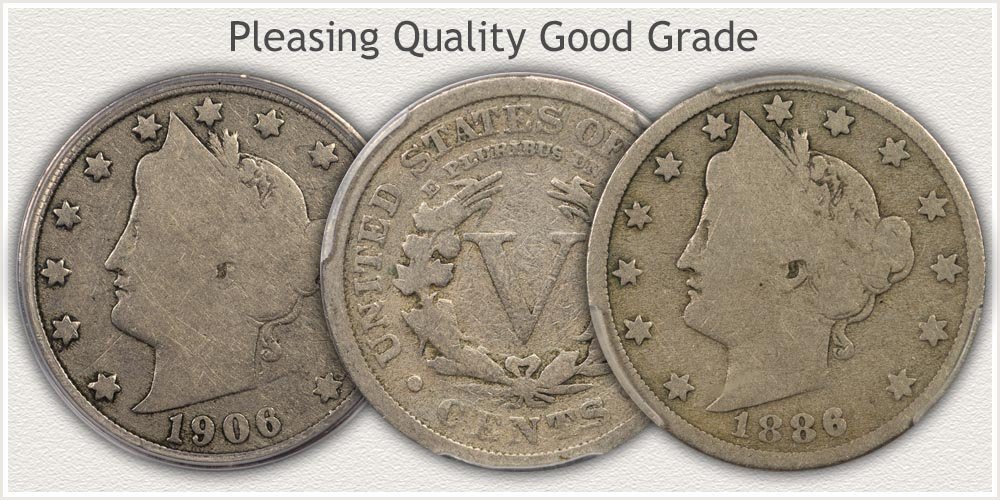 Worn but Still Nice Quality Liberty Nickels
Worn but Still Nice Quality Liberty Nickels
Each grade is suitable to apply the additional metrics of, pleasing toning, bold strike, and mark free surfaces. Good grade for example, starts with all major design features displayed, despite the amount of wear. It is also a grade attractive to new collectors as an affordable coin. Many dates in the nineteenth century in pleasing Good grade are significant to a beginning/young collector. Their search and eventual purchase support quality Good condition coins in the market. A well-chosen nickel features a raised portrait, and nice surface with wear balanced evenly.
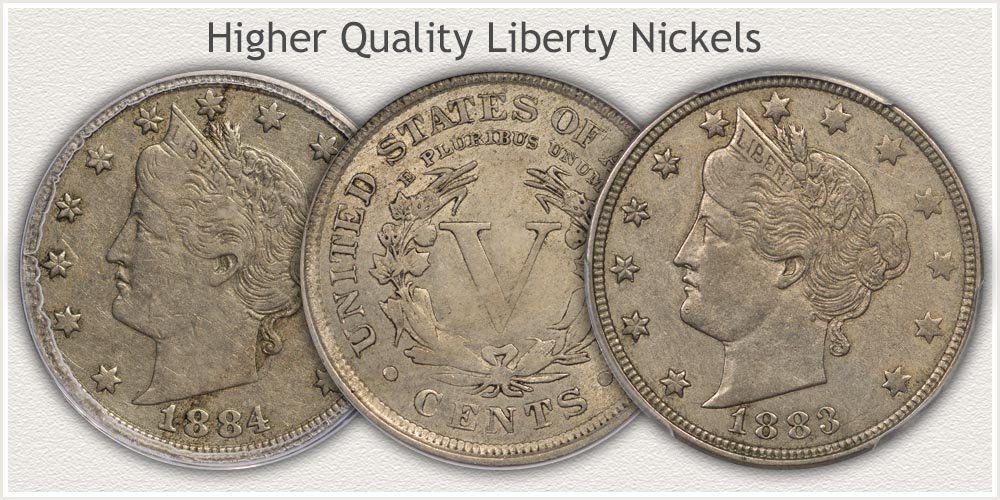 High Collector Quality Liberty Nickels
High Collector Quality Liberty Nickels
Continuing with circulated condition nickels, not all enthusiasts seek the ultimate grades of Mint State pieces. Completing a Liberty nickel collection featuring appealing, Extremely Fine condition coins is a rewarding challenge. Their pursuit of these coins is both a challenge and fun. Finding a pleasing, lightly circulated Liberty nickel is often a process of viewing many coins. Looking for the one with an even, sharp strike overall, eliminates many. Those without a distracting mark or two are next sorted. Pleasing natural light silver-gray toning without disturbances are in the minority. With an eye for these aesthetic qualities, the selected coin is well into a special class.
These three elements help define eye appeal. The first impression is an important consideration, separating and identifying a high-quality example within its grade. Each grade has its own positives, levels of design detail, and special qualities adding extra appeal to its grade category.
Your coin is a potential candidate for a passionate collector.
References
U.S. Mint. 1892 U.S. Mint Annual Report
https://nnp.wustl.edu/library/book/316
U.S. Mint. Catalogue of Coins of the United States.
https://nnp.wustl.edu/library/book/554591
Coin Values | CoinStudy Articles
Date by Date
In Depth Liberty Nickel Values
1883 to 1912
Old Nickel Values | Guide to Nickels
Become familiar with the different vintage nickel series, identified when matching them to images. Each series of nickels is covered with value charts and a step-by-step method to determine values. Shield to Liberty nickels are highlighted along with the popular Buffalo and Jefferson nickels. Important to value is condition, judged with descriptions, video, and detailed images.
The Value of V Nickels | Complete Value Chart
Spanning 30 years, Liberty nickel values vary widely. 1891 nickels are part of the early years of the series and begin with a premium worth. Find all dates listed on the chart.
Safe Coin Storage | Housing Liberty Nickel for the Long Term
Separating coins from each other avoids continued abrasions. Add protection from humidity provides the solution to storing these valuable Liberty nickels. Suitable products, specific to coins, are highlighted.
★Coin Values Discovery finds 1891 Nickel Value and...
Charts covering Coin Values. Start here with a step-by-step method used to narrow a range of how much old coins are worth. The different denominations and series of coins are covered with value charts, images to confirm dates, mintmarks, and condition. These are the key features to a complete evaluation.
